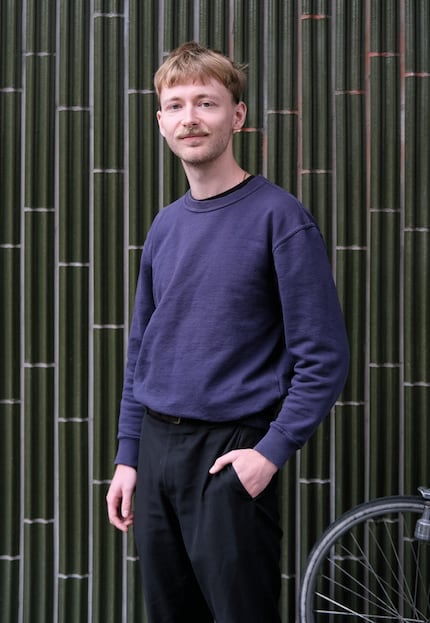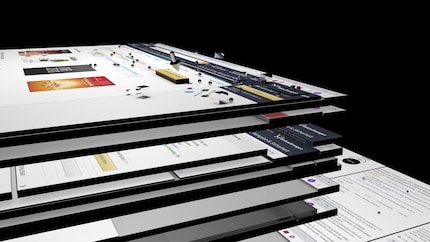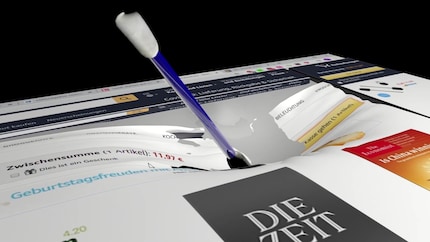
"Digital Patina": For a self-determined digital future
The "Digital Patina" prototype transforms user data into an aesthetic interface. It was created by designer Felix Schulz, who wants to encourage people to engage with digital traces.
So far, I have travelled through time with analogue or digital photo albums. Soon the same could be possible with my data traces on the Internet instead of photos: Felix Schulz's master's degree project Digital Patina turns a browser history and web cookies into a visual narrative. It is intended to illustrate the influence my actions and those of my "digital twin" can have. The recent Master's graduate from the "Trends and Identity" programme at Zurich University of the Arts explains what this means in an interview.
What is "Digital Patina"?
Felix Schulz: The Digital Patina Interface is both a theory and an experiment. It gives collected user data an aesthetic to enlighten you about your own traces on the web. Cookies are currently the only thing that records and stores web behaviour. They do this in written, data-based and not particularly descriptive form. With the Digital Patina prototype, a new form of communication is possible that is intended to sensitise people to the responsible use of data.

How did you come up with this idea?
The project started with a very small phenomenon. I read that it is possible to restore the text of old VHS tapes. Someone has written a programme for the "Linux" operating system. You will need a VHS recorder and a TV chip for the mainboard to feed the VHS video material as a TV signal. Finally, you get the teletext history back as code.
What fascinated you so much about it?I wanted to question what it actually is. A digital format in an analogue medium? A digital analogue track that can't be read? At the same time, I wanted to explore the question of how digital products actually age. The Office Assistant "Clippy" in Windows is an example of this. Such old user interfaces have a certain charm, but eventually fall into oblivion and lose their significance. I found this interesting alongside the romantic notion of teletext. I wanted to find out how these traces of digital use could be given a positive connotation. Then the concept of patina emerged, which is actually always associated with something positive.
How did you go about it?
At the beginning, I did a lot of research into where science actually stands in the visual realisation of digital tracks and spaces. Then I took a rather unorthodox approach and conducted ten interviews with people in the field. Five of them were completely from the analogue world: an image restorer, a precision mechanic, a palaeontologist and two archaeologists. I asked them all the same questions. What are traces? How do I systematise them? How do I make them visible? I gave the same questionnaire to five people who work in the digital field: a backend developer, a UX designer, a data forensic scientist, a data scientist and a forensic scientist.
What did you find out when analysing the answers to your questions?
My aim was to develop codes and concepts that deal with the systematisation and processing of evidence. I wanted to create a theoretical basis and clarify how traces can be clustered. With the aim of approaching different companies and offering them a repertoire that can be used to visualise traces.

You then used your prototype to demonstrate the purchase of a toilet brush in an online shop. What traces become visible here?
So far, you know the normal two-dimensional website view, in which no traces are visible. With Digital Patina, there would be a button to activate that converts the user interface from 2D to 3D and shows you what you have done on this page in the last three years. In an online shop, for example, this is always the customer journey. You could run a metal detector over the layers and, for example, track which funnel you came through and when on a visually interesting interface. It should be fun to discover traces.
«We come from a digitally educated background. But that doesn't necessarily mean that we handle our data better.»
Why was it important to you to design the tracks spatially?Because they don't just appear on flat surfaces. In archaeology, surfaces are exposed layer by layer so that they can be viewed in cross-section. This involves working with light. The pathologist told me that at night on the beach, light beams are used for hours just to look at where the ground is and how it is and where it is lighter or darker. In archaeology, a drone now flies over surfaces to see where snow melts faster, for example. So there must be an option to get closer to things.
Digital Patina is not yet fully developed in terms of complexity. The first approach is that you have tools at your disposal, such as a digital cotton bud, to go on a voyage of discovery. You use a digital spade to dig through a customer journey or website history. It should be possible to click on old structures to bring them back to the top.

Can I use the tools to change the patina afterwards?
Yes, exactly. I want us to stop seeing our digital twin as a necessary evil that exists somewhere, shielded as much as possible. My aim is to turn it and the data into something interesting and to change people's consciousness. With the Digital Patina Interface, you can destroy certain information and decide what you want to see.
Why do you want to give users control over the data produced?
There is an unequal relationship when it comes to data usage. You agree to cookies and receive a free service based on them - a "good" offer. However, a company benefits much more from this data generation than we do as users. It is unpleasant to agree to a regulation whose result I cannot see. If I could see the data in a form other than text, I could understand and influence the whole thing. I want to strengthen the user's position. That way, they have a new point of view vis-à-vis the company.

Who is Digital Patina for?
The interface is aimed at companies and users. As soon as open technical questions have been clarified, Digital Patina is intended to create a new level of security for you. And give you an answer to the question of what digital trust looks like. If I have a secure framework, I can make better decisions and place my trust in a company.
Digital Patina aims to reduce IT complexity. That should also be in the interests of a company. When it says: We're giving you back control over your data and the power to make decisions. We still want to use it, but only the data that you make available - then it would be more of a relationship at eye level and customer loyalty could improve. A company that takes care of customer relations with more than just SEO text is likely to be favoured. You might no longer go to a company that doesn't have the Digital Patina option.
«The more transparent a company is and explains what happens to the data from cookies on the website, the less anti is the attitude towards data usage.»
What's the next step?
Firstly, I found two people from ETH Zurich who see Digital Patina as an inspiration and are interested in building a website from it. This will initially visualise cursor movements as a heat map and make them interactive via Google Analytics. I also want to optimise the display of terms of use and cookies. These are often long texts. If you take a closer look, they often contain the same information for different companies. I imagine videos that visualise what happens to the data that you produce on a website in the future. Customers shouldn't be put off by long texts, but should be informed in a contemporary way.
Like a cheerleader, I love celebrating good design and bringing you closer to everything furniture- and interior design- related. I regularly curate simple yet sophisticated interior ideas, report on trends and interview creative minds about their work.
From the latest iPhone to the return of 80s fashion. The editorial team will help you make sense of it all.
Show all